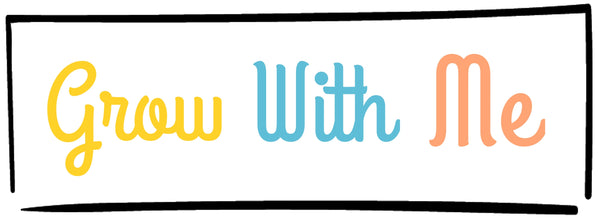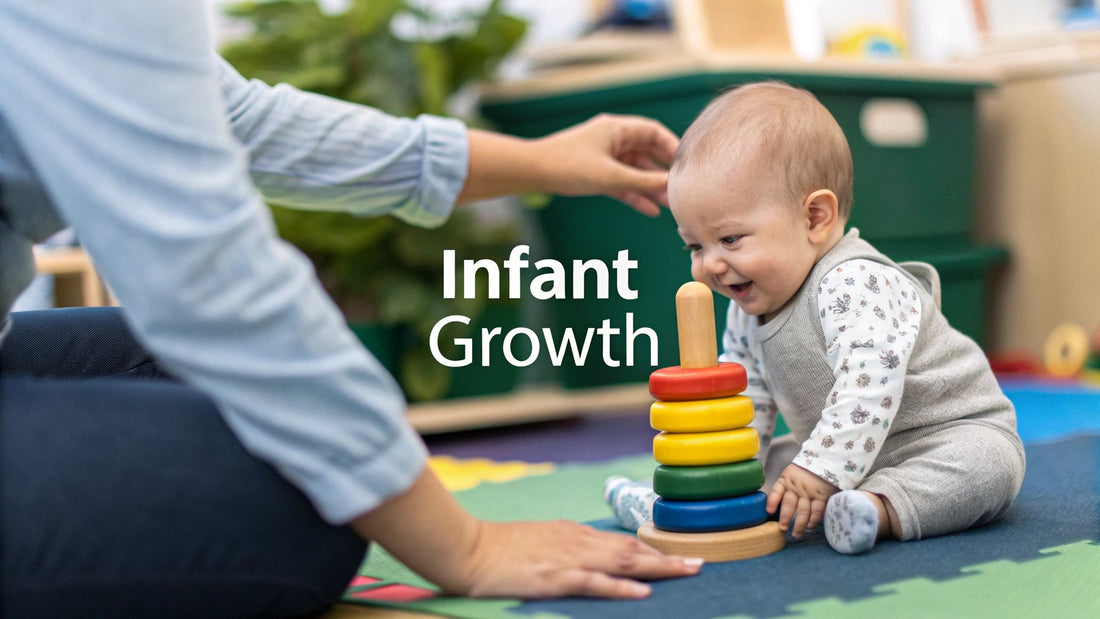
Top Developmental Activities for Infants to Boost Growth
Share
When we talk about “developmental activities” for babies, it sounds complicated, doesn’t it? In reality, it’s just a fancy term for the simple, playful ways we interact with our little ones every day. It’s about turning nappy changes, bath time, and cuddles into moments that spark connection and learning. Forget the complicated toys; it’s all about quality engagement.
Understanding Your Infant's Developmental Journey
That first year is a whirlwind of incredible growth. Behind every gurgle, wiggle, and fumbled grasp, your baby's brain is forging millions of new connections. When you understand the main areas of development, you start to see the magic happening in those everyday moments, which gives you the confidence to support their progress naturally.
These developmental areas don’t operate in silos—they're all woven together. Think about a simple game of peek-a-boo. It’s more than just a sweet distraction. It’s teaching your baby about object permanence (a huge problem-solving leap!) while also building social bonds and encouraging those first smiles and giggles.
The Five Core Areas of Infant Growth
Your baby’s development is a holistic journey, and experts typically look at it through five main lenses. Knowing what they are helps you appreciate how different activities contribute to their overall progress.
- Communication: This is everything from their first cries and babbles to recognising your tone of voice and understanding gestures.
- Gross Motor Skills: We're talking about the big movements here—using their arms, legs, and torso to lift their head, roll over, and eventually, start crawling.
- Fine Motor Skills: This covers the smaller, more precise movements, like gripping a rattle, bringing their hands to their mouth, or picking up a soft piece of food.
- Problem-Solving (Cognitive Skills): This is all about how your baby learns and figures things out. It starts with tracking a moving toy with their eyes and leads to discovering cause and effect (like when they realise shaking a rattle makes a noise!).
- Personal-Social Skills: This is the beautiful process of connecting with others. It’s learning to smile, making eye contact, and starting to read social cues from the people they love most.
In England, these five areas are so fundamental that they form the foundation of developmental checks. In fact, recent government data from 2023 to 2024 revealed that 80.4% of children aged 2 to 2.5 years met their expected milestones across all five domains. That's a slight but encouraging increase from the previous year. You can dive deeper into the findings on the official government statistics page for child development outcomes.
The visual below shows tummy time in action. It's one of the most important early activities, as it strengthens the neck, shoulder, and back muscles that are crucial for all those major motor milestones to come.
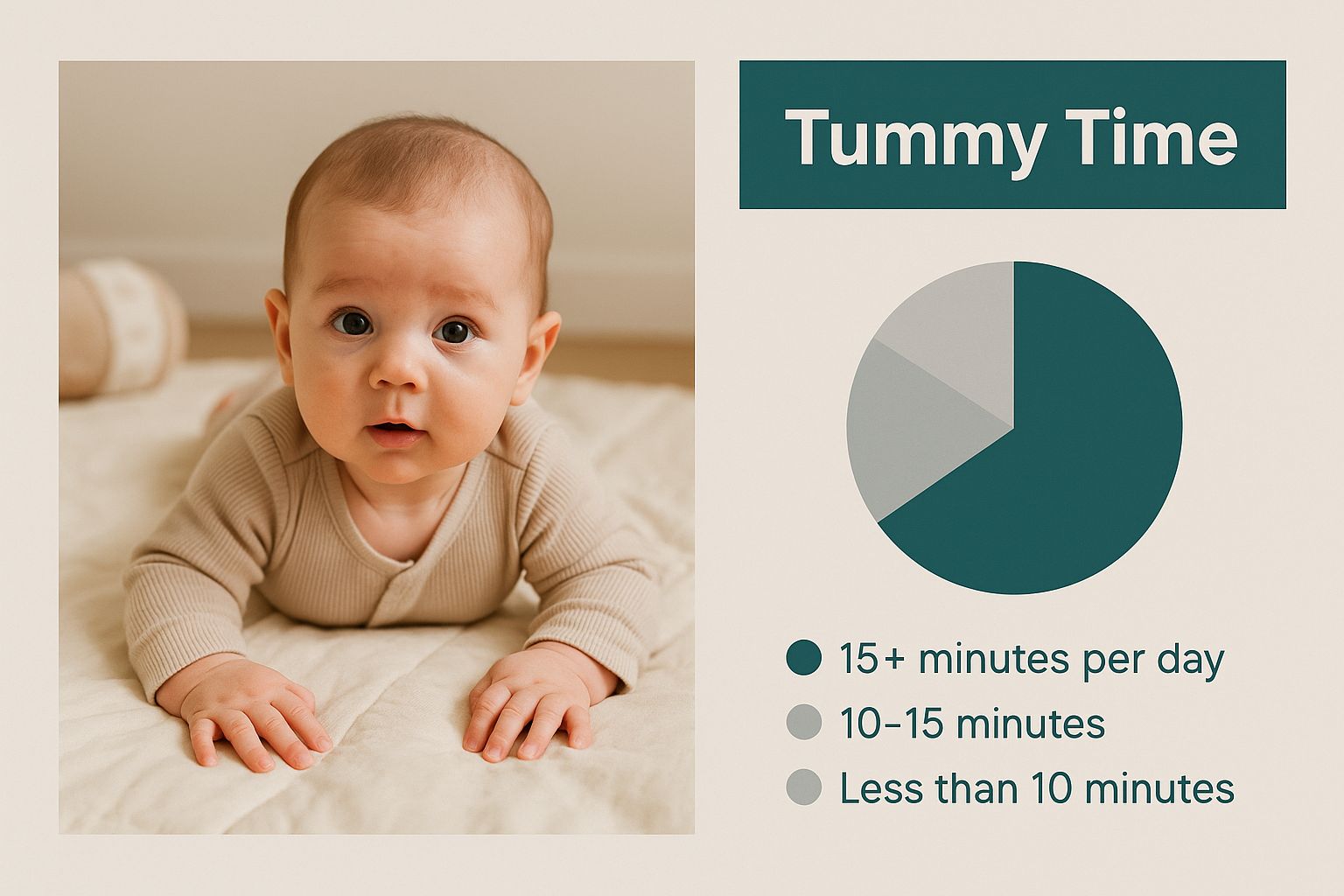
This simple act is a perfect example of how one activity can tick multiple developmental boxes at once.
Core Developmental Domains at a Glance
To bring this all together, here’s a quick summary of how these domains work and what they look like in everyday play.
| Developmental Domain | What It Involves | Simple Activity Example |
|---|---|---|
| Communication | Expressing needs and understanding language, both verbal and non-verbal. | Singing nursery rhymes and making exaggerated facial expressions. |
| Gross Motor Skills | Using large muscle groups for movement like sitting, rolling, and crawling. | Placing a favourite toy just out of reach during tummy time to encourage stretching. |
| Fine Motor Skills | Developing small muscle control in the hands and fingers for grasping. | Offering a soft, textured ball or a crinkly fabric book for them to hold. |
| Problem-Solving | Thinking, learning, and understanding the world around them. | Playing peek-a-boo to introduce the concept of object permanence. |
| Personal-Social | Interacting with others, forming relationships, and showing emotions. | Mirroring your baby’s coos and babbles to show you're listening and engaged. |
Seeing it laid out like this makes it clear just how interconnected everything is. A single, loving interaction can support your baby's growth in so many ways.
Remember, these milestones are a flexible guide, not a strict checklist. Every baby develops on their own unique timeline. The goal is to create a loving, supportive environment where learning happens naturally through play and connection. Your responsive engagement is the most powerful tool you have.
Nurturing Your Newborn From Birth to Three Months
Those first three months with a new baby are an incredible blur of feeding, sleeping, and soaking up all the cuddles. It might not look like much is happening, but your newborn's brain is firing on all cylinders, taking in every single sight, sound, and touch. In this delicate "fourth trimester," developmental activities for infants are less about doing and more about simply being together.
Honestly, your face is the most captivating toy your baby will ever own. Holding them close, letting them gaze at your features, and watching them try to focus is a profoundly powerful activity. Just smile and talk to them softly. This is how you build those crucial first bonds and help their vision sharpen day by day.
Making Tummy Time Engaging
We all hear about how vital tummy time is for building the neck, shoulder, and back muscles they’ll need for rolling over and crawling later. But let's be real—many newborns absolutely despise it at first. The secret is to start small, with very short but frequent sessions, and make it a positive experience for everyone involved.
- Get down on their level. Lie on the floor with them, face-to-face. Your presence is incredibly reassuring and gives them something wonderful to focus on.
- Bring in some visuals. A baby-safe mirror or a few high-contrast flashcards can work wonders. The bold black-and-white patterns are much easier for their developing eyes to see and will really grab their attention.
- Mix up the surfaces. Tummy time doesn't always have to be on the floor. Try doing it on your chest while you're reclined on the sofa. This doubles as skin-to-skin contact, which is brilliant for comforting them and helping to regulate their heart rate.
These early weeks are all about laying the foundations. If you look at milestones for infants from birth to 18 months, you’ll see how these simple activities connect to bigger skills. For example, by 3 months, most babies in the UK can lift their head and chest during tummy time and start batting at toys, showing their hand-eye coordination is kicking in. You can find more great information on this from the Buckinghamshire Healthcare NHS Trust.
Awakening Their Senses
Your newborn is a tiny sponge, learning about the world entirely through their senses. Gentle, simple stimulation is the perfect way to help them process all this new information without getting overwhelmed. The easiest way to do this is to weave sensory moments into your daily routine.
A soft rattle or a crinkly toy provides just the right amount of sound to get their attention, teaching them the early concept of cause and effect—"when I move, it makes a noise!" You really don't need a mountain of toys. A few carefully chosen items are far more effective. To help you get started, we've put together a guide on the best toys for newborn development that are perfect for this stage.
The most important "activity" you can do is simply respond to your baby's needs with warmth and comfort. Every time you soothe their cries, you are teaching them that they are safe and loved—a lesson that forms the foundation of all future learning.
Encouraging Visual Tracking
Your baby’s eyesight is still quite blurry, but they are already working on tracking slow-moving objects. This is a huge skill that builds the groundwork for focus and depth perception.
It's easy to practise this together. Take a colourful, soft scarf or a simple toy and hold it about 20-30 centimetres from their face. Once you’ve got their attention, move it very slowly from one side to the other. You’ll see their little eyes trying to follow it. You can do the exact same thing with your own face, just moving slowly from left to right. These tiny moments of play are actually powerful workouts for their visual pathways.
Engaging Your Baby From Four to Six Months
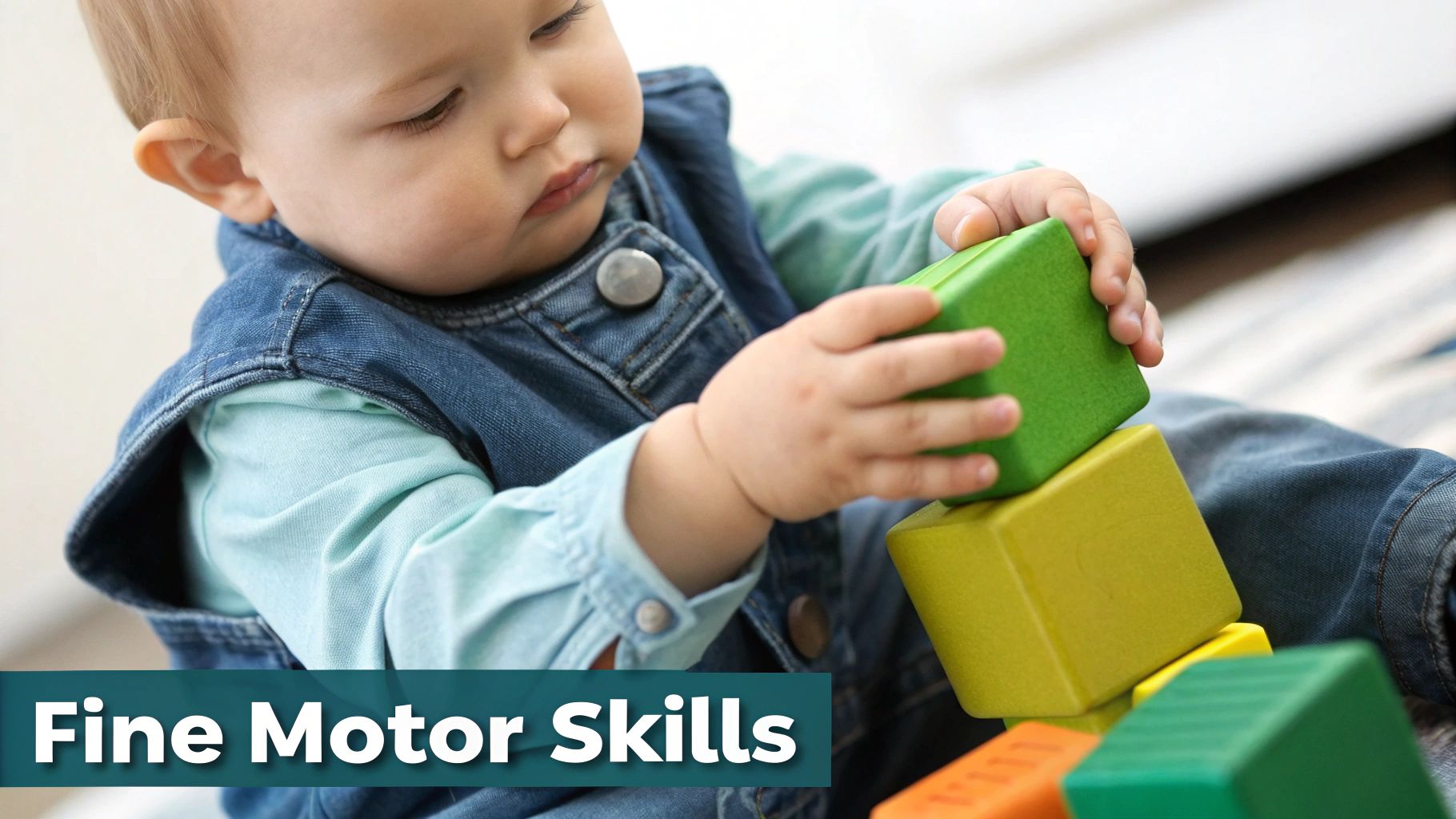
Get ready for some real fun! This is the stage where your baby’s little personality starts to burst through. Between four and six months, you’ll see a massive leap in how they interact with the world. They’re becoming more mobile and their movements are starting to look much more deliberate.
Because they’re likely rolling over (or trying very hard to!), the floor is now their main stage for play and discovery. It’s no longer just about lying there; they are actively reaching, exploring, and figuring out what their amazing little body can do. This makes it a golden opportunity for all sorts of developmental activities for infants.
Inspiring Movement and Grasping
Babies at this age are driven by curiosity, especially when it comes to interesting objects. You can use this to your advantage to help them build crucial motor skills. During tummy time, try placing a favourite rattle or a crinkly toy just a tiny bit out of their reach. You'll see them pivot, stretch, and maybe even start to push up, all of which works wonders for their back, arm, and core strength.
You'll also notice that everything—and I mean everything—goes into their mouth. This is completely normal and a key way they explore. Their grasp is becoming less of a reflex and more of a choice, so offering a variety of safe, textured toys is a brilliant way to help them refine those fine motor skills.
- Textured Balls: A soft, bumpy ball is fantastic because it's easy for little hands to grip and offers great sensory feedback.
- Fabric Books: We love books with crinkly pages or different textures. They’re a feast for the senses.
- Silicone Teethers: These are a must-have for mouthing, helping your baby learn about different shapes and textures safely.
The real aim here is to create a 'yes' space on the floor. It should be a safe, inviting environment where their natural curiosity can take over. Just a few well-chosen, stimulating items are all they need to practise reaching, grasping, and developing that all-important hand-eye coordination.
The Magic of Back-and-Forth Play
Your little one is now becoming a proper social partner. They're starting to understand the wonderful rhythm of a 'serve and return' interaction, which is the absolute foundation of communication. These back-and-forth moments are where the real connection and learning happen.
You can encourage this simply by responding to their signals. When they make a sound, copy it back to them. When they flash you a gummy smile, beam one right back. This shows them their efforts to communicate are seen and heard, which is incredibly powerful. If you’re looking for more ideas, our guide on fun 4-month-old activities has lots of lovely inspiration for this stage.
Reading simple board books together is another fantastic activity. Point to the bright colours and name the pictures. It honestly doesn't matter if they seem more interested in chewing on the corners! They're still soaking up the sound of your voice and learning that books are part of a warm, cuddly time with you. These shared moments are true building blocks for their growing brain and their little heart.
Your Baby's Big Adventures: Seven to Twelve Months
Get ready, because your baby is on the move! This incredible stage, from seven to twelve months, is when their world truly opens up. You might have a speedy crawler on your hands, a little one pulling up on every piece of furniture, or even a brave explorer taking those first wobbly steps.
With this newfound freedom comes a massive surge in curiosity. Our focus with developmental activities for infants now shifts to nurturing their budding independence and supporting their ever-expanding cognitive skills.
The trick is to create a safe ‘yes’ space. Good baby-proofing means you can relax a little, knowing they can explore their surroundings without you having to say "no" all the time. This freedom is essential for building their physical confidence and their little problem-solving brains. Think of yourself as their supportive co-pilot, cheering them on from the sidelines.
Getting Them Moving With a Purpose
Now that your little one is moving with more intention, you can use simple games to encourage them. Rolling a colourful ball just out of their reach can be the perfect motivation for that determined army crawl across the living room floor, strengthening their core muscles and coordinating their arms and legs. It's never about pushing them, but about creating little invitations to challenge themselves.
This is also the perfect time for toys that get them on their feet. A sturdy activity table or even just the edge of the sofa provides brilliant support as they practise pulling themselves up to stand. This is a huge workout for their leg muscles and a massive milestone on the road to walking.
Mastering Those Tiny Hand Movements
While big movements like crawling and cruising steal the show, their little hands are getting so much cleverer. This is often when you’ll see the pincer grasp emerge—that clever ability to pick up small things with just their thumb and forefinger. It's a game-changer for fine motor control and unlocks a whole new level of play.
You can easily encourage this skill with things you're already doing.
- Snack Time Practice: Scatter a few soft cereal puffs or tiny pieces of cooked carrot on their highchair tray. This gives them a brilliant (and tasty) opportunity to practise that pincer grasp.
- The In-and-Out Game: Find a small, baby-safe pot or box and some chunky wooden blocks. The simple act of dropping things in and tipping them out again is endlessly fascinating for them. It’s a hands-on lesson in cause and effect and fantastic for their hand-eye coordination.
- Stacking and Toppling: Stacking cups are a classic for a reason! They teach about size, spatial awareness, and, of course, the sheer joy of knocking it all down.
It's worth remembering that the best activities are often the simplest. It’s the repetition and exploration that build strong connections in your baby's brain. Letting them work out how to fit the block in the box is where the real learning happens.
Building Early Communication Skills
Even if they aren't saying much more than "dada" or "mama," your baby's understanding of language is exploding right now. This is a hugely important window for communication, and the way you talk with them is the single best tool they have for learning. They're soaking up the rhythm of conversation and making connections between words and the world around them.
Simply narrating your day is one of the most powerful things you can do. As you're getting them dressed, you can say, "Let's put on your cosy blue jumper." At the park, point things out: "Look at that big, fluffy dog!" This constant, gentle stream of language builds a rich foundation for their vocabulary.
Action songs and rhymes are also absolute gold. Think 'Pat-a-Cake', 'Incy Wincy Spider', or 'Row, Row, Row Your Boat'. These classics brilliantly link words to actions, helping to cement their meaning in your baby's mind. Singing together is more than just a language lesson; it’s a wonderful way to connect and make learning feel like a joyful, shared game.
The Real Impact of Play and Your Engagement
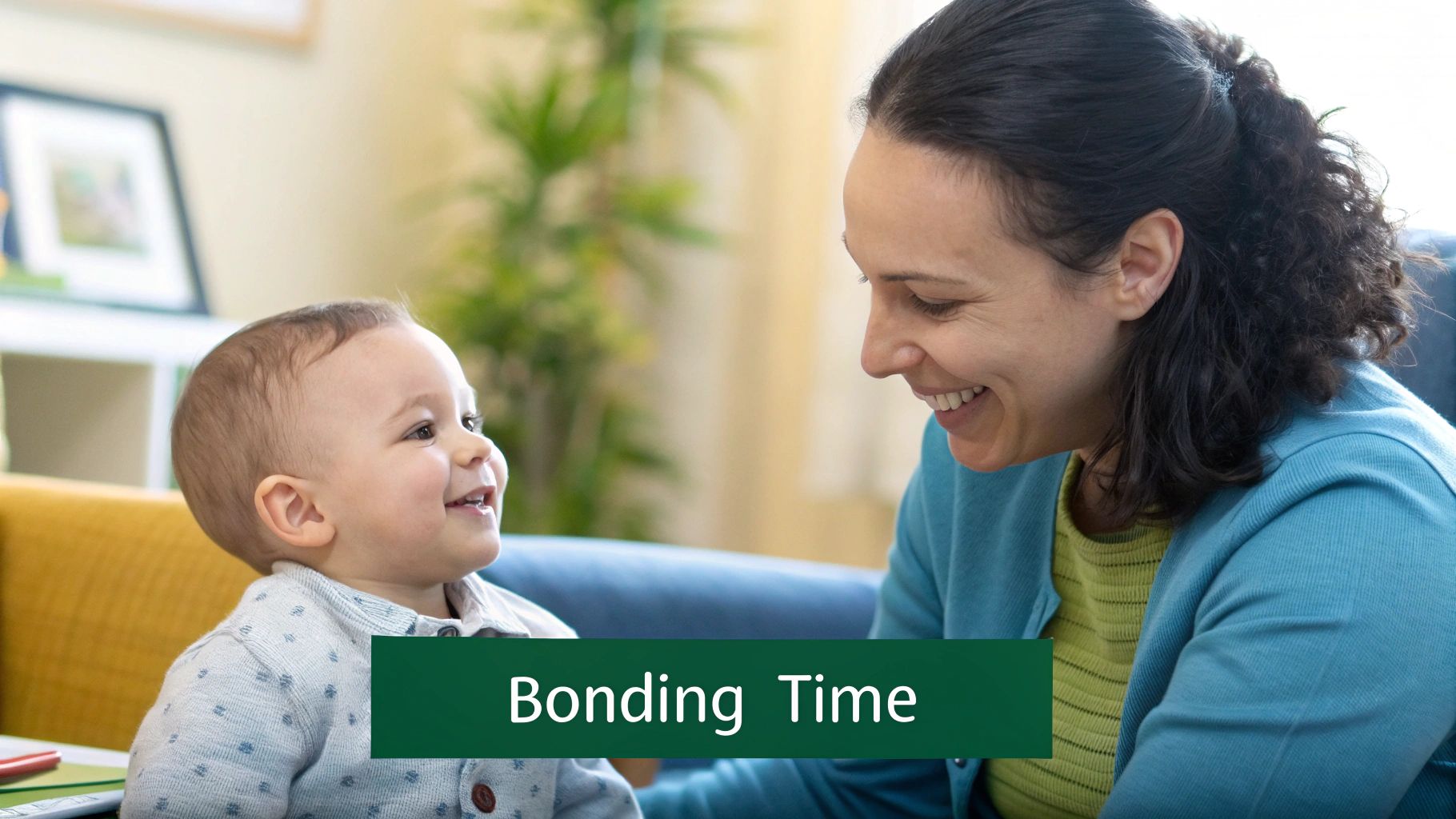
It’s easy to get caught up in the ‘what’—the specific toys and games we should be using. But the real magic, the thing that truly makes a difference, lies in the ‘why’ and, even more so, the ‘how’. The developmental activities we've talked about are fantastic, but their power is only fully unlocked by one simple thing: you.
Every time you smile back at your baby, copy their coos, or pull them in for a soothing cuddle, you’re doing something incredibly profound. These aren't just sweet, fleeting moments. They are the literal building blocks of a secure attachment, which is the foundation for all their future learning and emotional wellbeing.
Your Connection Is the Key
Your relationship is, without a doubt, the most important ‘toy’ your baby will ever have. It's in those loving, back-and-forth interactions that your baby learns they are seen, heard, and safe. That security is what gives them the confidence to start exploring the big, wide world around them.
The best part? This doesn’t require any special equipment or elaborate setups. It happens naturally during nappy changes, in the middle of bath time, or during those quiet moments on the playmat. The quality of your connection matters far more than the quantity of toys you own. For more ideas on using simple play to build this bond, take a look at our guide to the best sensory toys for babies.
The most effective developmental tool you possess is your consistent, loving attention. These everyday moments of shared joy and comfort are actively shaping your child’s brain architecture for a lifetime of learning and resilience.
How Simple Interactions Build a Strong Brain
When you interact with your baby, you are quite literally helping to build their brain. Responding to their babbles, for instance, strengthens the neural pathways for language. Playing a game of peek-a-boo doesn't just get a giggle; it’s teaching them about object permanence—a massive cognitive leap!
This kind of responsive caregiving creates a brilliant positive feedback loop. Your baby signals a need or an interest, you respond to it, and their brain makes a new connection. It’s a simple but incredibly powerful process that bolsters their ability to learn and manage emotions as they grow.
We can see the effect of this early engagement in wider developmental outcomes. Data from early childhood monitoring in England showed that in 2020-2021, 82.9% of children aged 2 to 2½ years were meeting expected levels across all five key areas of development. This really highlights how vital it is for little ones to have supportive environments and meaningful developmental activities for infants.
Ultimately, your role isn't about being a perfect parent or a master entertainer. It’s simply about being present and responsive. By celebrating their tiniest achievements and comforting them through their little frustrations, you are giving them the greatest gift of all: a secure and loving foundation from which to grow.
Still Have Questions About Your Baby's Development?
Even with a mountain of information, it’s only natural for questions to pop up as you find your way through your baby's first year. Every little one follows their own unique timeline, which can sometimes leave you wondering what’s what. Let's tackle some of the most common queries I hear from parents.
Remember, you know your baby better than anyone. Think of this as a guide, but always trust your own parental intuition – it's your best tool.
How Much Tummy Time is Actually Necessary?
This is the big one, isn't it? The key here is to start small and build up gradually. For a brand new baby, we're talking moments, not marathon sessions. Aim for just 2-3 minutes at a time, a few times a day. After a nappy change or when they're awake and settled after a nap are often perfect windows of opportunity.
As they get stronger, you can start stretching out those sessions. The long-term goal is to reach a total of about 20-30 minutes spread throughout the day by the time they hit three or four months old. What really matters is consistency, not how long one particular session lasts. And it goes without saying, but always stay right there with them during tummy time.
My Baby Hates Every Activity I Try
Oh, we’ve all been there! You lay out a beautiful sensory activity, and your baby just stares blankly at the ceiling or starts fussing. It’s completely normal for babies to have their own preferences or just not be in the mood for a certain game.
First, run through a quick mental checklist: are they tired, hungry, or maybe just craving a cuddle? If their basic needs seem met but they're still not engaging, try stripping the activity back to basics or just moving to a different room. Sometimes simply swapping a toy or finding a quieter spot can change everything.
The most important thing is to never force it. If an activity is a flop, just move on. Letting your baby take the lead is a brilliant developmental activity in its own right. Sometimes, just a quiet snuggle and watching the world go by is the most valuable experience you can share.
When Should I Worry About My Baby’s Progress?
While it’s true that every baby hits milestones at their own pace, you should also trust your gut if a worry keeps nagging at you. After all, you're the expert on your child. Missing a single milestone by a little bit is rarely a cause for concern, but it's always worth having a chat with your health visitor or GP for reassurance.
A few things to keep an eye out for would be:
- Losing skills they once had.
- Noticeably favouring one side of their body over the other.
- Seeming unusually stiff or, conversely, very floppy.
If you start to notice a consistent pattern of delays across several areas, seeking professional advice is the right move. It means you can get support early if needed, and at the very least, it will put your mind at ease.
Ready to make playtime meaningful without the guesswork? The Grow With Me play kits are designed by experts to perfectly match your baby's developmental stage. Discover your first box today and have age-appropriate toys delivered straight to your door.
